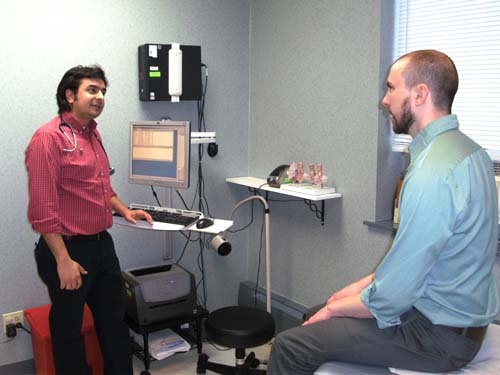
If Congress hadn’t passed the American Recovery and Reinvestment Act of 2009 a year before health care reform, the new law’s technology provisions might have looked very different.
ARRA pumped $25.8 billion into health care information technology, including $19.2 billion as incentives for doctors and hospitals that make “meaningful use” of IT, plus grants for work force training, regional “extension centers,” regional-exchange development, and more.
With this huge cash infusion, combined with detailed new standards that are still being finalized, the stimulus bill “will really determine the path of [health care IT]” in the coming years, as Dr. Cedric J. Priebe, chief information officer for Care New England, put it.
But make no mistake: health care IT, or HIT as it is commonly referred, is a big part of the reform law as well – just in a different way.
“There are [more than] 50 provisions in this bill that reference use of HIT,” said Laura Adams, president and CEO of the Rhode Island Quality Institute, which has led local IT adoption efforts, including the creation of a statewide information exchange known as currentcare.
Parts of the reform law address HIT-adoption directly, Adams noted, such as a grant program to encourage long-term care facilities to use electronic health records. But more notably, HIT is part of provisions about delivery-system redesign, quality improvement and innovation.
“If we didn’t clearly understand the foundational role of HIT before, we certainly do now,” Adams said, “because it’s repeated throughout this bill, how it’s going to be used to reform the health care system.”
To some extent, the reform law presumes that doctors and hospitals will have the technology they need, Adams said, “but there’s also a nod to the fact that we aren’t quite there.” So while under ARRA, the government is setting standards for “meaningful use,” the new law includes grants and pilots that apply HIT along those lines, such as to measure outcomes and costs.
The law also creates a Center for Medicare and Medicaid Innovation, she added, that will provide even more opportunities to develop and expand programs that use HIT as a tool in delivery-system redesign and quality improvement.
At the same time, as the Quality Institute rolls out a new “extension center” – funded by ARRA – to help doctors with EHR adoption, it’s already treating IT as an “on-ramp” to greater innovation, Adams said, making doctors aware of the CSI model and helping them become eligible not just for HIT incentives, but also for medical-home incentives.
For community health centers, which are getting a particularly big boost from health care reform, the HIT and delivery-system improvement provisions are very important, said Maria Montanaro, president and CEO of Thundermist Health Center.
Thundermist is part of CSI and is also piloting a small health information exchange in Woonsocket, a sort of small-scale trial of currentcare. It has five staff members analyzing quality measures from its EHR and using them to improve care, and it’s well ahead of most of the state in building an “advanced medical home.”
Health care reform includes “many features” that will support those efforts, Montanaro said, and it will help Thundermist do more health promotion and education in the community, and more preventive work such as obesity management.
“These are some of the best things we do in health care, and they’re mostly unreimbursable,” Montanaro said. The reform law, which provides for investments in new delivery systems and payment models, could dramatically change that, she said.
Raymond Lavoie, executive director of Blackstone Valley Community Health Care, describes the reform law in similar terms: He said it will build on several years of work funded by ARRA and other sources to develop HIT systems, a sophisticated quality reporting system, a medical-home model, and a small health information exchange that Blackstone Valley is creating.
“It’s going to be fantastic, well ahead of anything that exists in the state,” Lavoie said. And yes, he explained, funding for this and other projects on the agenda comes from programs approved before health care reform, but the new law will bring new opportunities.
Of course a lot of the ARRA-funded work is just getting started. In February, the Quality Institute was awarded a $6 million grant to develop the “extension center,” which is close to becoming active, Adams said, and it got $5.28 million for currentcare.
The new cash gave a big boost to currentcare, and then the late-March floods came, and the Hewlett-Packard data center in Warwick where the system’s servers were housed got inundated, ruining the equipment, Adams said. There was no data loss, she stressed, but now new equipment must bought, so some upgrades are being made as well.
Last week, the Quality Institute was awarded another ARRA grant, for $15.9 million, as part of a program to create HIT “Beacon Communities.” It will fund 12 initiatives that build on existing efforts, including one to link the NextGen network to currentcare.
Discussions also continue about how best to attain “meaningful use” standards, including data-sharing and patient-access requirements.
Those who are already actively innovating, such as early EHR adopters, and smaller, nimbler organizations, are less anxious, Adams said, but larger organizations will need to adjust.
“Almost always, in the wake of very significant and mandated change, there is a bit of people retrenching,” she said. “It is intimidating and concerning when you’re not exactly sure how things are going to play out.”
Looking ahead, however, Adams is very optimistic.
“There are so many things that have come out of this legislation that are so good,” she said. •











